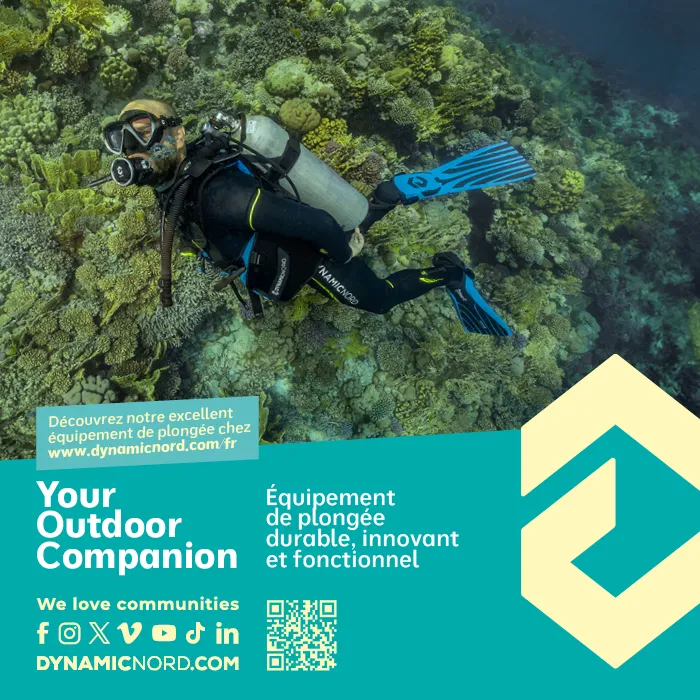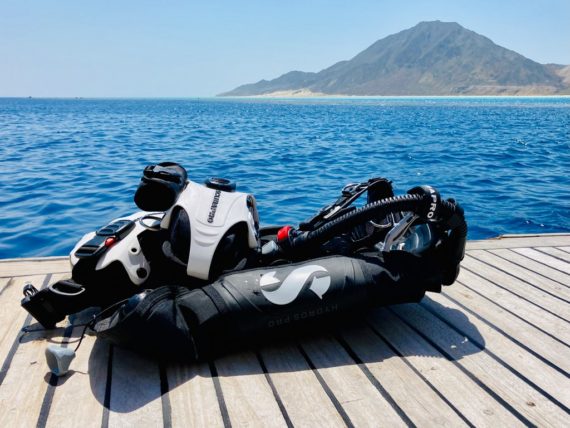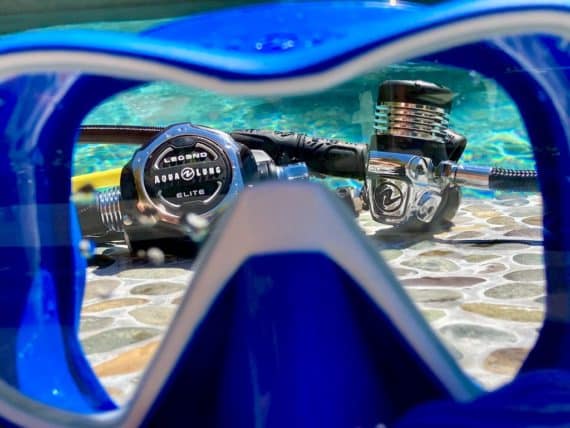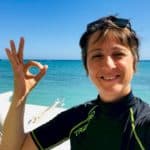TEST : Sidemount Diving

Sidemount diving
It’s been a while since I wanted to test sidemount diving. If several people had offered me to learn this particular form of diving configuration (thank you 🥰),I had not been able to do in a concrete way.
Also, when the conditions were met and my photographer friend Laurent Miroult offered me to try sidemount diving, I said YESSSSSSSSSSSSSSSS.
So we go to a dive spot, a cold quarry in Belgium one morning in May. It’s 4°C outside, but the sun is starting to shine and we’re happy to be here.
I had asked my buddy to take a GO pro, because I wanted to concentrate fully on the experience. Arriving on the spot, we realize that Laurent planned to make me and Didier try sidemont diving. Forget the pictures, we’re going to test the sidemount and I’m happy.
As I had no underwater image, I had given up writing an article from this experience. But I did not resist. You’re going to have to read… and imagine.

First explanations
Laurent immediately warns me: “I’m not an instructor, I just share with you what I usually do and the advice I’ve been given during my training.”
I am especially delighted to be able to put myself back in a learning situation for once. Everything will go like a charm, I’m convinced.
We agree to do a dive not deeper than -20 m and focus on the position, the sensations, the use of both regulators, the closing and opening of both valves …
Our guide of the day explains the specifics of the equipment and makes sure that the straps and other weighting settings are correct. He also tells us that we have to make sure to breathe 30 bars on one bottle and then 30 bars on the other. Okay, I can do that. In fact, the explanations are quite simple.
From a material point of view, I will dive with the stab of Rob Neto (a pro for this type of diving) when he comes to dive in our lands. This is top! Two small 7-litre bottles inflated at 300 bars will complete the equipment. A gas stock of more than 4000 litres. Not bad compared to my 15 litre tank at 220 bars (3300 liters).
Laurent warns us that we may feel like we are being put forward with sidemount diving. I keep that in mind.
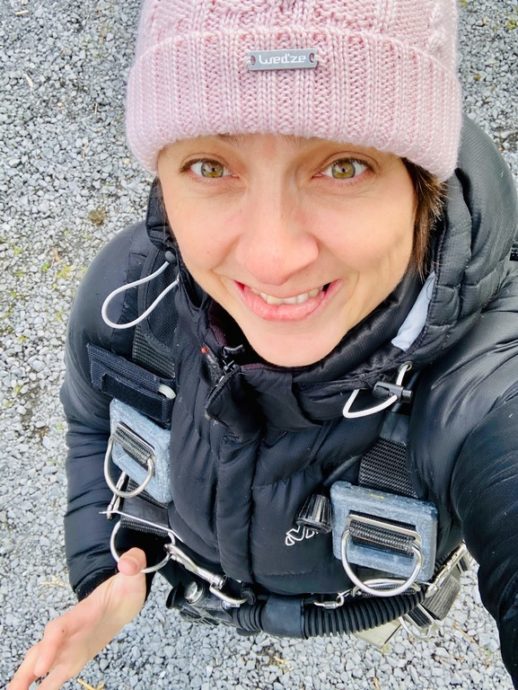
Preparation… sidemount diving
That’s one of the reasons I wanted to learn sidemount: Here, everything is easy and lightweight. I bring the two light tanks to the water’s edge.
After getting equipped, I put on the appropriate BCD and arrive quietly in the water, effortlessly. I always quickly reach the water to no longer feel the weight of my equipment. Because a dry suit with a 15-litre tank, the weight needed for diving and thermal comfort, it’ heavy !
Then comes the time to position the tanks for sidemount diving. Well, it gets a little tougher because we have our big dry gloves. But it’s not really complicated (says the girl who had hung her tanks to the wrong hooks at the back of the BCD #jaipaslesyeuxdansledos).
READ | Aqua Lung’s LEGEND 3 Elite Regulator : The Ultimate TEST
Diving
Since now, it’s WAOUH!
I have this pleasant feeling of floating (which is the case) and being light. Not trapped in my usual equipment… free. No impression of being put forward either.
We demonstrate to Laurent that we can easily change regulators and offer the long Hose (a regulator with a longer hose) to our buddy. I love being a student.
And then it’s off for 60 minutes of diving.
Obviously, I’m having fun making somersaults. Turning around and going back. I was expecting to rock from one side to the other, but the opposite is happening. The movements are fluid, the buoyancy natural. I can rotate on myself horizontally without feeling unbalanced. Passing under obstacles I feel however that my feet are slightly higher than usual.
I don’t see my position in the water, but I observe that Didier and Laurent are quite horizontal. Later, Laurent will tell me that even if my position was pretty good, I didn’t have the perfect trim. He thinks that the material is not fully adapted. The unacademic way of having fixed the weight at the back (fortunately there is no photo) is the main reason. We’re going to have to do it again.
READ | Solo Diving : Between Freedom And Danger
End of diving
We have to put an end to this dive. We surface, remove our tanks and walk to our vehicles. Once we have pull of our BCD, we return to pick up the tanks at the water’s edge. Nothing is heavy, nothing at all, I love it!
Learn more about sidemount diving
What I liked most
- Clearly, the weight that should not be carried at once before and after diving.
- The position in the water
- Perfect redundancy and easy to access (much easier to access valves than with a twin tank)
- The impression of lightness and freedom (impossible to bang your head on the valve of the tank 😉)
- Lightness of material
- Opportunity to sneak into narrow places without hanging anything
What I liked less
(There, I have to look)
- I didn’t have my thermoformed mouthpiece
- There were no lip-covers (and it’s cold in the water in Belgium)
- Hanging the tank at the back of the BCD with dry gloves is a bit complex. But it’s not forbidden to get help, is it?
- I do not have a picture of the experience (#commentça, it has nothing to do? 😁)
What is sidemount diving?
While it is becoming more common, sidemount diving has historically been the tool of highly technical divers who wish to enter hard-to-reach places (e.g. resurgences or shipwrecks). These people are looking for ways to sneak through narrow passages and to do that, they need suitable equipment.
Indeed, the principle of sidemount diving is to configure its equipment in such a way as to position it on the side or sides of the diver. This, while being able to easily and simply place it in front of you also to be less wide in case of narrow passage.
Here, no tanks on the back, but just against the flanks.
READ | On A Boat, How To Easily Get Ready With Your Dive Stuff In 5 Steps
Materials for sidemount diving
This lateral assembly does require specific equipment.
A harness with a wing (a buoy called a wing attached only to the back) replaces the classic diving BCD.
Generally for sidemount diving, two tanks will be placed on either side and passing under your arms. Note that some dive with a single tank. However in the environment where I usually dive, redundancy (duplication of all material) is mostly the focus. Both tanks have a regulator with a hose to connect to the BCD or drysuit inflator and a gauge.
Diving sidemount: for whom?
In my opinion, this type of diving can be suitable for a very large number of people. For technical divers that need to go through narrow places. But also people with back problems who cannot carry loads. Or just those who want to test new experiences
Train and go further
It is not always necessary to speak to an instructor to learn a new skill (but to be certified yes). However, I should point out that most of the time, the instructors will anticipate your questions and will easily give you the necessary information. This will save you time and allow you to acquire the right gestures. Usually, instructors have this characteristic of having learned to teach, remember this.
To go further, you can read books on the subject including The excellent book by Rob Neto
Am I going to continue in that direction?
The answer is clearly yes and I am already looking at what would be the ideal equipment for me.
In the meantime, I would like to thank Laurent Miroult once again through this article. But also Jerome who unfortunately could not be with us for this experience of diving sidemount. Finally, all the people who had previously offered me to test their equipment and with whom I could not carry out this test.
In addition, even though he is not an instructor, I would like to emphasize the very strong pedagogical sense of our guide of the day. Indeed, his explanations were clear and precise.
Do you like sidemount diving? Do you know anything about that? What are your tips and tricks?
Tell me this in a comment below to benefit more people.
And above all… remember to be happy 🤗
Helene

